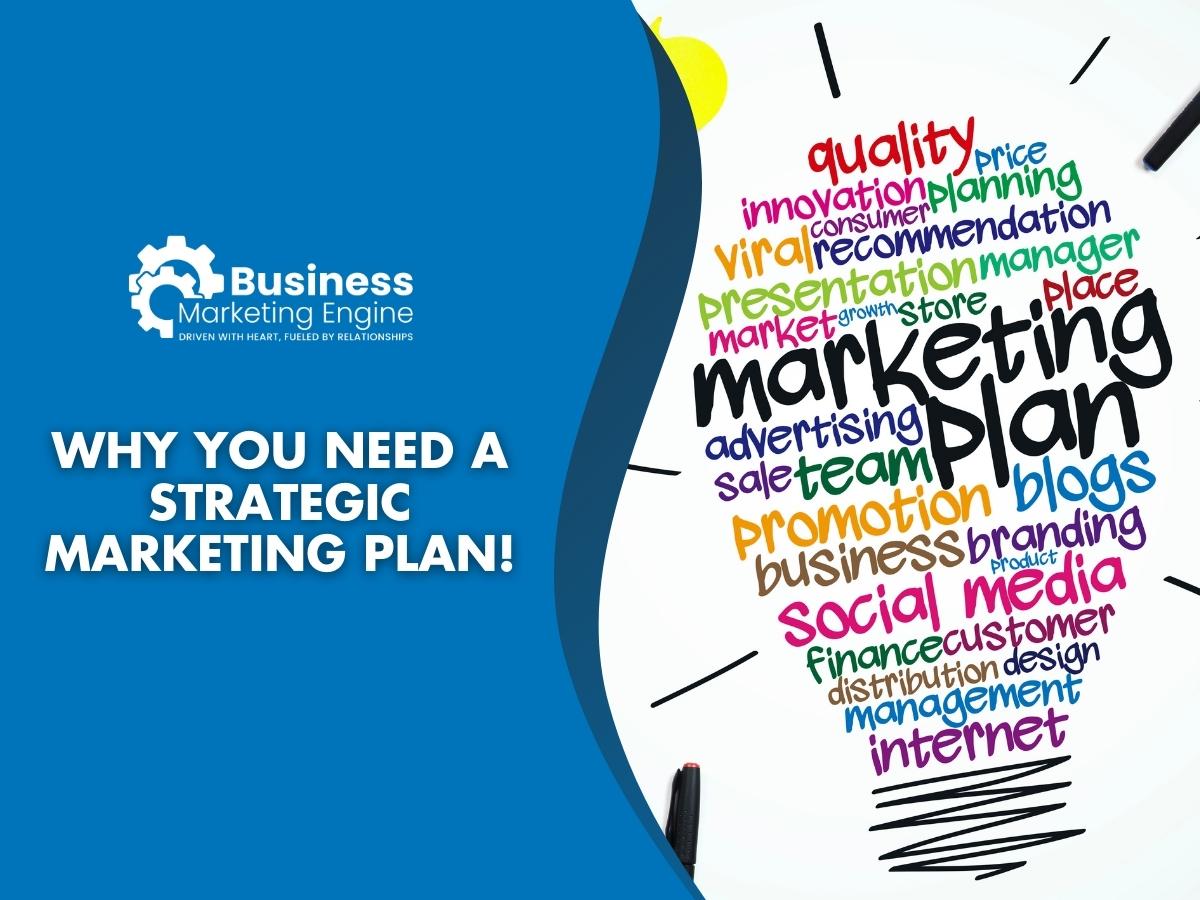Strategic marketing plans are essential for growing businesses.
Visit the U.S. Small Business Association or Investopedia, and they’ll tell you the same. As a matter of fact, visit any online guide about developing your business plan, and you’ll find something amazing. Most, if not all, resources include a portion highlighting the importance of marketing strategies.
But why? Why are strategic marketing strategies so fantastic that they have every resource on the internet chatting about them? The answer is simple.
A strategic marketing plan creates a united front for your business– a force incorporating every asset you have available. A good one can practically deliver your ideal audience to your doorstep (or inbox) overnight.
And that’s true no matter what industry you serve.
At Business Marketing Engine, we’ve created strategic marketing plans for clients in multiple industries. From landscaping to personal injury law, we’ve done it all. That’s a way of saying that we know what we’re discussing here. And lucky for you, we’re going to use our experience to explain strategic marketing plans to you– inside and out.
If you want to ensure your business has the help it needs, continue reading! We have you covered.
What is a Strategic Marketing Plan?
“The majority of business (people) are incapable of original thinking because they are unable to escape from the tyranny of reason. Their imaginations are blocked.” – David Ogilvy, founder of Ogilvy & Mather, the “Father of Advertising.”
We’ve hyped strategic marketing plans up enough for the time being. So, let’s get real. Let’s discuss what these plans are for you as a business leader. In other words, let’s discuss why you should care enough to invest your time and resources.
At its core, a strategic marketing plan is a living document that evolves and grows with your business. It should incorporate your business’s short-term and long-term objectives– anything and everything important to your business.
A good plan will also consider your current financial standing and impactful trends in the marketplace. That way, you can actively plan to take what you have, invest in trends and then create something more.
At Business Marketing Engine, we help clients build holistic 12-month strategic marketing plans to grow and scale their businesses. We start by conducting deep market research to understand the client and their goals. Then, using that information and considering their long-term targets, we create a step-by-step, consistent plan to attract their ideal audience.
Whether digital or traditional, we cover all marketing methods and channels to maximize brand reach– as your plan should. With a proper plan in place, as we have described, your marketing dollars will be better invested.
Do you want to learn more about our strategic marketing process and ensure your marketing dollars are safe?
Book a call with Business Marketing Engine now!
What Are the Main Components of a Strategic Marketing Plan?
Now that we have your interest. Let’s discuss the five primary components of your typical strategic marketing plan. Just remember that these components may vary slightly depending on the industry. These are just the components that typically find a place everywhere.
Positioning of The Company – SWOT Analysis
A SWOT analysis is a strategic planning/ management technique to help you identify your business’s strengths, weaknesses, opportunities and threats. It’s also called a situational assessment or situational analysis. And in this case, it’s the very first component of a solid strategic marketing plan.
Whether you create your marketing plan in-house or not, a SWOT analysis will be part of the process. They can help you identify your previous strategies and assess the success of your plan against the target financial results. Simply put, a SWOT analysis allows you to look before you leap.
Organizational Goals and Strategies
No strategic marketing plan is complete without goals and corresponding strategies.
The goals, in this case, would be targets to rationalize the allocation of resources. Basically, you need a reason to invest your time and money. A good example of a goal would be increasing brand awareness.
On the flip side, strategies are meant to convert your lofty goals into reality. For example, to increase your brand awareness, an effective strategy would be to boost your marketing efforts. That way, your brand appears in people’s lives more often– building trust and achieving top-of-mind awareness.
You can check out more about top-of-mind awareness over here. It’s worth taking the time to get familiar with it. We enjoy talking about it here.
Market Assessment
Your plan should always consider emerging market trends and plan to take advantage of them in the future. Doing so will help your business invest in the most promising opportunities and avoid wasting valuable marketing dollars. A market assessment will help your team spot those promising opportunities before launching any efforts.
 Target Market
Target Market
It’s very important to define specific target groups for every single product and service. In this step, you can conduct more research and discover emerging needs and demands. Addressing those can help your marketing efforts succeed in the long run.
The tricky part here is that needs and demands will vary significantly depending on your industry. So, if you’re coming from another market, don’t just assume the same needs are present. They’re likely completely different.
Entire Marketing Budget
A strategic marketing plan must always include a realistic marketing budget and schedule marketing efforts over time. That means you have to make some tough decisions. Specifically, you need to decide what you can afford to spend your budget on and who should do what.
For instance, who would be in charge of running ads, and how much can they spend on them? You need to answer similar questions and a marketing strategy will help you do that.
For those of you who are new to the marketing world, creating a good budget can be difficult. We understand that. That’s why we’re going to link a resource for you to learn more about marketing budgets. Check it out to learn more and start building yours today. Click here.
The Advantages of Having a Strategic Marketing Plan for All Industries
If you want advantages, look no further. For starters, the process of creating a plan like this builds a common understanding between all stakeholders in an organization. In turn, it can also help smooth management decisions, boost the behavior of employees and enthusiasm from clients.
Aside from that, a strategic marketing plan can enable a business to grow its market share, resulting in more revenue and profit. And all of that is just the beginning.
But let’s recap here and look at all the advantages, so you don’t lose track of anything.
Identify your Target Market
We mentioned target groups before for a very good reason. By targeting specific groups and using an effective marketing plan, you can identify and understand your ideal customers. And address their pain points with your marketing efforts and products.
It will also help you position yourself as a friend rather than another business trying to make a generic pitch.
After all, according to Peter Drucker, “The aim of marketing is to know and understand the customer so well the product and services fits him and sells itself.”
Identify your Competitors
With a SWOT analysis, you can identify your competitor’s strengths and weaknesses. And possibly, find a gap in the market that you can fill. When used correctly, the information gained can help you beat the competition ahead of you and win your audience’s trust.
Not sure how to find your competitors?
Don’t worry. For the most part, a SWOT analysis will help you do it. But if you need more, you can embrace the Sherlock Holmes mentality and do some investigating. This article should give you the help you need to get started.
Boosts ROI on Marketing Spend
Return on investment is critical. Without it, your business won’t have the revenue needed to support team members or provide value to an audience. And eventually, it will stall. Luckily, a strategic marketing plan will help boost your ROI on marketing spend and redirect that revenue into other opportunities.
Overall, it’s a must if you want security in your business.
Builds a Strategy to Target Ideal Customers
Every strategic marketing plan utilizes deep market research to map out strategies guaranteed to hit specified goals. That will help your business avoid marketing activities that don’t support your strategy. In other words, you won’t waste any more money.
FREE Strategic Marketing Plan Template
While handling all of this in-house may not be 100 percent best for your business, you can do it!
You just need a little guidance, and you’re in luck because we’re here for you. Below, we designed a template to help you create your strategic marketing plan from A to Z. Set aside some time and start filling out the template now!
The only way you can make progress in marketing is if you make it happen.
[Company name]
Marketing mission statement: (how your marketing strategy will support your organization’s business objectives)
SWOT Analysis Results (Be sure to )
Strengths: Describe what separates you from the market. (E.g., We have a loyal customer base and unique technology.)
Weaknesses: Define anything that holds your business back. (E.g., We have high levels of debt and an inadequate supply chain.)
Opportunities: List any opportunities for your business. (E.g., We have the opportunity to sell in a new market.)
Threats: You need to actively keep track of your organizational threats. (E.g., Threats could be increasing competition, high material costs and things of that nature. )
Marketing actions
[Action 1]
Overview: Briefly describe the initiative. (E.g., We’ll build a library of infographics to help our customers understand market trends.)
Desired outcome: What’s your goal? (E.g., We want to increase organic traffic to our resource library by 3 percent over the next quarter.)
KPI / Metric: How will you objectively measure your outcome? (E.g., Page visitors, time-on-site, clicks, etc.)
[Action 2]
Overview:
Desired outcome:
KPI / Metric:
Market segments
[Segment 1]
Demographics: Superficial details about your audience. (E.g., gender, age, income and marital status.)
Psychographics: What motivates your audience? (E.g., personal interests, attitudes, values, desires.)
Challenges: What problems do they need to overcome?
Preferred channels: Where do they absorb industry news? Where do they go to ask questions and seek professional insights?
Preferred content types: How do they prefer to gain new knowledge? Do they like video, audio or written content?
[Segment 2]
Demographics:
Psychographics:
Challenges:
Preferred channels:
Preferred content types:
Buyer Personas
[Persona 1]
Name: Each persona should have a unique name.
Age: What’s the average age range of this persona?
Job title: List a few common job titles.
Motivations / goals: What do they hope to achieve? What drives them?
Personal interests: What do they like to do outside of work?
Challenges: What business challenges do they face? What’s stopping them from achieving their goals?
[Persona 2]
Name:
Age:
Job title:
Motivations / goals:
Personal interests:
Challenges:
There it is! With this template, you’ll be one step closer to every advantage that we carefully listed above.
However, before you run off, we have to state the obvious. A strategic marketing plan can only help your business if you create one. Better yet, a strategic marketing plan can only help you if it’s good.
So make it and take your time.
There’s no need to rush this process.
Just trust the template and reach out to us whenever you need help. At Business Marketing Engine, we know how to create a strategic marketing plan because we’ve done it a thousand times. With our range of marketing experts supporting you, you and your business can prosper far into the future.
From web design and strategic marketing plans to a full branding package, we can help with anything and everything.
Just book a call with us to learn more.
You won’t regret it.

 Target Market
Target Market



